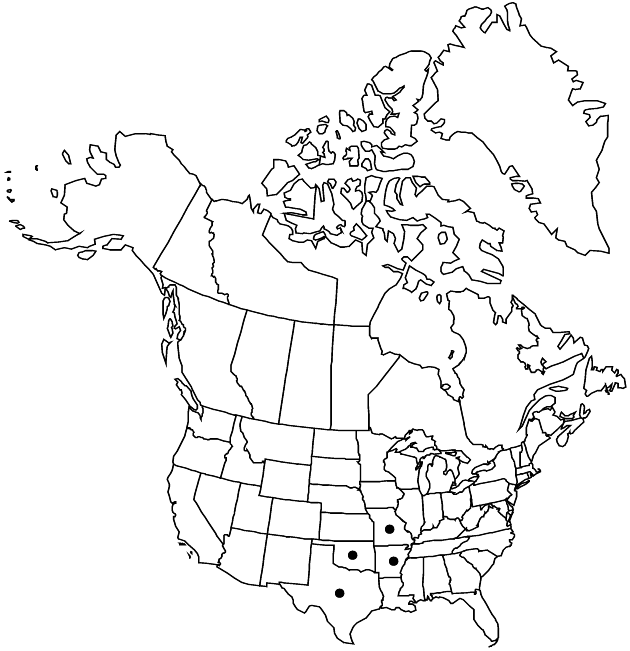Difference between revisions of "Echinacea paradoxa"
in N. L. Britton and A. Brown, Ill. Fl. N. U.S. ed. 2, 3: 476. 1913.
FNA>Volume Importer |
RevisionBot (talk | contribs) m (Bot: Adding category Revised Since Print) |
||
| (8 intermediate revisions by 3 users not shown) | |||
| Line 1: | Line 1: | ||
{{Treatment/ID | {{Treatment/ID | ||
|accepted_name=Echinacea paradoxa | |accepted_name=Echinacea paradoxa | ||
| − | |accepted_authority=(Norton) Britton | + | |accepted_authority=(Norton) Britton |
|publications={{Treatment/Publication | |publications={{Treatment/Publication | ||
|title=in N. L. Britton and A. Brown, Ill. Fl. N. U.S. ed. | |title=in N. L. Britton and A. Brown, Ill. Fl. N. U.S. ed. | ||
| Line 7: | Line 7: | ||
|year=1913 | |year=1913 | ||
}} | }} | ||
| − | |basionyms={{Treatment/ID/ | + | |special_status={{Treatment/ID/Special_status |
| + | |code=E | ||
| + | |label=Endemic | ||
| + | }}{{Treatment/ID/Special_status | ||
| + | |code=C | ||
| + | |label=Conservation concern | ||
| + | }} | ||
| + | |basionyms={{Treatment/ID/Basionym | ||
|name=Brauneria paradoxa | |name=Brauneria paradoxa | ||
|authority=Norton | |authority=Norton | ||
| + | |rank=species | ||
| + | |publication_title=Trans. Acad. Sci. St. Louis | ||
| + | |publication_place=12: 40, plate 8. 1902 | ||
}} | }} | ||
|synonyms= | |synonyms= | ||
| Line 19: | Line 29: | ||
}}<!-- | }}<!-- | ||
| − | --><span class="statement" id="st-undefined" data-properties=""><b>Plants </b>to 90 cm (roots fusiform to elongate-turbinate, branched). <b>Herbage</b> sparsely to densely hairy (hairs appressed to ascending). <b>Stems</b> usually yellowish green (usually not branched). <b>Basal</b> leaves: petioles 0–15 cm; blades (3-) or 5-nerved, usually linear or lanceolate, rarely ovate, 5–35 × 0.5–2(–2.5) cm, bases usually attenuate, margins entire (usually ciliate). <b>Peduncles</b> (2–)10–30 cm. <b>Phyllaries</b> lanceolate to ovate, 7–12 × 1–4 mm. <b>Receptacles</b>: paleae 10–14 mm, tips red to orange, often incurved, sharp-pointed. <b>Ray</b> corollas yellow (var. paradoxa) or pinkish to white (var. neglecta), laminae reflexed, 30–70 × 3–8 mm, sparsely hairy abaxially. <b>Discs</b> ovoid to conic, 2–3.5 × 2–3.5 cm. <b>Disc</b> corollas 4.5–6.2 mm, lobes pinkish to yellowish. <b>Cypselae</b> tan or bicolored (with distal dark brown band), 4–5.5 mm, faces ± tuberculate, usually glabrous (angles of ray cypselae hairy distally in var. neglecta); pappi to ca. 1.2 mm (major teeth 0–4).</span><!-- | + | --><span class="statement" id="st-undefined" data-properties=""><b>Plants </b>to 90 cm (roots fusiform to elongate-turbinate, branched). <b>Herbage</b> sparsely to densely hairy (hairs appressed to ascending). <b>Stems</b> usually yellowish green (usually not branched). <b>Basal</b> leaves: petioles 0–15 cm; blades (3-) or 5-nerved, usually linear or lanceolate, rarely ovate, 5–35 × 0.5–2(–2.5) cm, bases usually attenuate, margins entire (usually ciliate). <b>Peduncles</b> (2–)10–30 cm. <b>Phyllaries</b> lanceolate to ovate, 7–12 × 1–4 mm. <b>Receptacles</b>: paleae 10–14 mm, tips red to orange, often incurved, sharp-pointed. <b>Ray</b> corollas yellow (<i></i>var.<i> paradoxa</i>) or pinkish to white (<i></i>var.<i> neglecta</i>), laminae reflexed, 30–70 × 3–8 mm, sparsely hairy abaxially. <b>Discs</b> ovoid to conic, 2–3.5 × 2–3.5 cm. <b>Disc</b> corollas 4.5–6.2 mm, lobes pinkish to yellowish. <b>Cypselae</b> tan or bicolored (with distal dark brown band), 4–5.5 mm, faces ± tuberculate, usually glabrous (angles of ray cypselae hairy distally in <i></i>var.<i> neglecta</i>); pappi to ca. 1.2 mm (major teeth 0–4).</span><!-- |
-->{{Treatment/Body | -->{{Treatment/Body | ||
| − | |distribution= | + | |distribution=Ark.;Mo.;Okla.;Tex. |
|discussion=<p>Varieties 2 (2 in the flora).</p> | |discussion=<p>Varieties 2 (2 in the flora).</p> | ||
|tables= | |tables= | ||
| Line 46: | Line 56: | ||
-->{{#Taxon: | -->{{#Taxon: | ||
name=Echinacea paradoxa | name=Echinacea paradoxa | ||
| − | + | |authority=(Norton) Britton | |
| − | |authority=(Norton) Britton | ||
|rank=species | |rank=species | ||
|parent rank=genus | |parent rank=genus | ||
| Line 53: | Line 62: | ||
|basionyms=Brauneria paradoxa | |basionyms=Brauneria paradoxa | ||
|family=Asteraceae | |family=Asteraceae | ||
| − | |distribution= | + | |distribution=Ark.;Mo.;Okla.;Tex. |
|reference=None | |reference=None | ||
|publication title=in N. L. Britton and A. Brown, Ill. Fl. N. U.S. ed. | |publication title=in N. L. Britton and A. Brown, Ill. Fl. N. U.S. ed. | ||
|publication year=1913 | |publication year=1913 | ||
| − | |special status= | + | |special status=Endemic;Conservation concern |
| − | |source xml=https:// | + | |source xml=https://bitbucket.org/aafc-mbb/fna-data-curation/src/2e0870ddd59836b60bcf96646a41e87ea5a5943a/coarse_grained_fna_xml/V19-20-21/V21_210.xml |
|tribe=Asteraceae tribe Heliantheae | |tribe=Asteraceae tribe Heliantheae | ||
|subtribe=Asteraceae (tribe Heliantheae) subtribe Ecliptinae | |subtribe=Asteraceae (tribe Heliantheae) subtribe Ecliptinae | ||
| Line 65: | Line 74: | ||
}}<!-- | }}<!-- | ||
| − | -->[[Category:Treatment]][[Category:Echinacea]] | + | --> |
| + | |||
| + | [[Category:Treatment]] | ||
| + | [[Category:Echinacea]] | ||
| + | [[Category:Revised Since Print]] | ||
Latest revision as of 19:28, 6 November 2020
Plants to 90 cm (roots fusiform to elongate-turbinate, branched). Herbage sparsely to densely hairy (hairs appressed to ascending). Stems usually yellowish green (usually not branched). Basal leaves: petioles 0–15 cm; blades (3-) or 5-nerved, usually linear or lanceolate, rarely ovate, 5–35 × 0.5–2(–2.5) cm, bases usually attenuate, margins entire (usually ciliate). Peduncles (2–)10–30 cm. Phyllaries lanceolate to ovate, 7–12 × 1–4 mm. Receptacles: paleae 10–14 mm, tips red to orange, often incurved, sharp-pointed. Ray corollas yellow (var. paradoxa) or pinkish to white (var. neglecta), laminae reflexed, 30–70 × 3–8 mm, sparsely hairy abaxially. Discs ovoid to conic, 2–3.5 × 2–3.5 cm. Disc corollas 4.5–6.2 mm, lobes pinkish to yellowish. Cypselae tan or bicolored (with distal dark brown band), 4–5.5 mm, faces ± tuberculate, usually glabrous (angles of ray cypselae hairy distally in var. neglecta); pappi to ca. 1.2 mm (major teeth 0–4).
Distribution

Ark., Mo., Okla., Tex.
Discussion
Varieties 2 (2 in the flora).
Selected References
None.
Key
| 1 | Ray corollas yellow; n Arkansas, s Missouri | Echinacea paradoxa var. paradoxa |
| 1 | Ray corollas light purple, pink, or white; s Okla-homa, n Texas | Echinacea paradoxa var. neglecta |